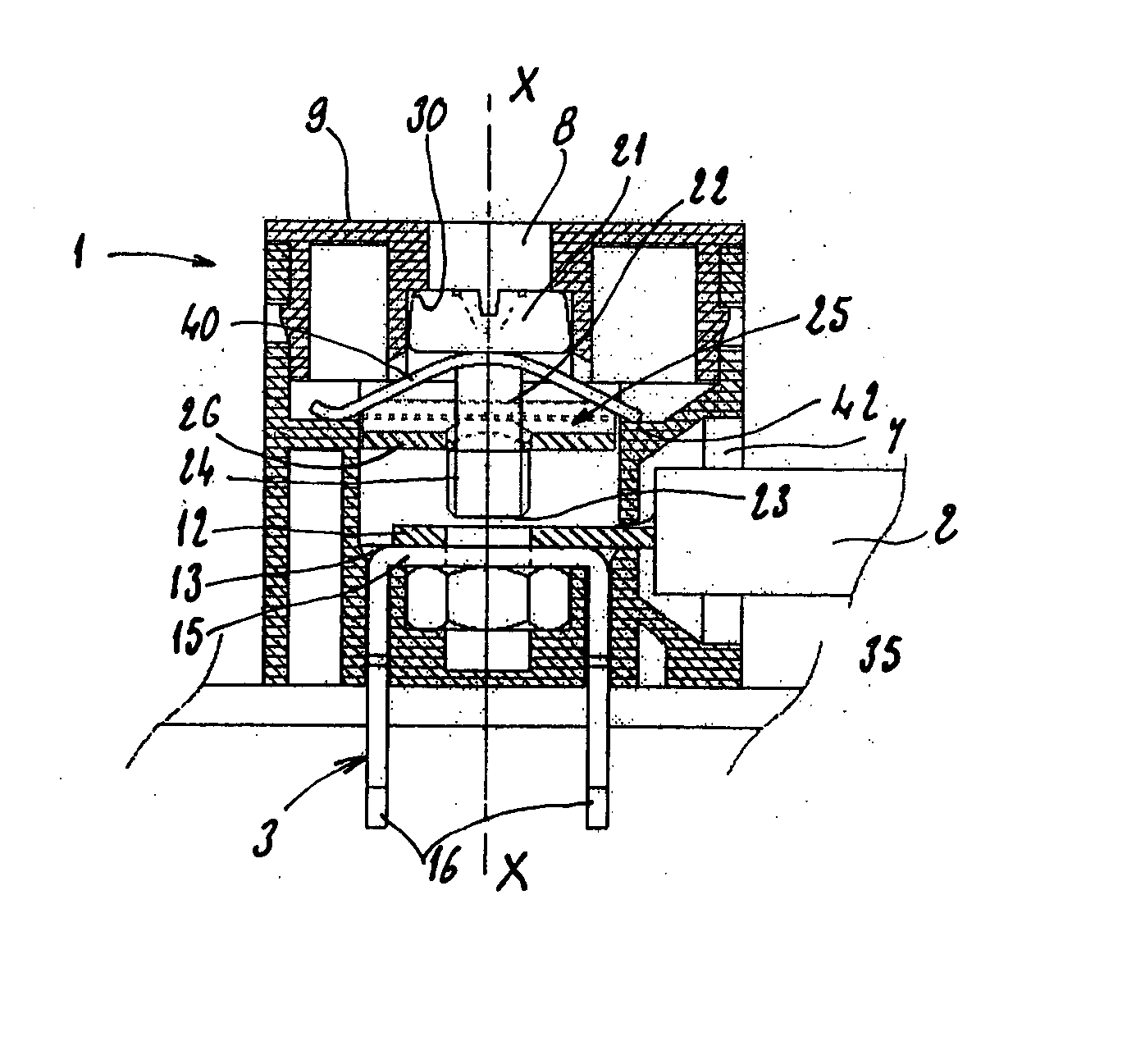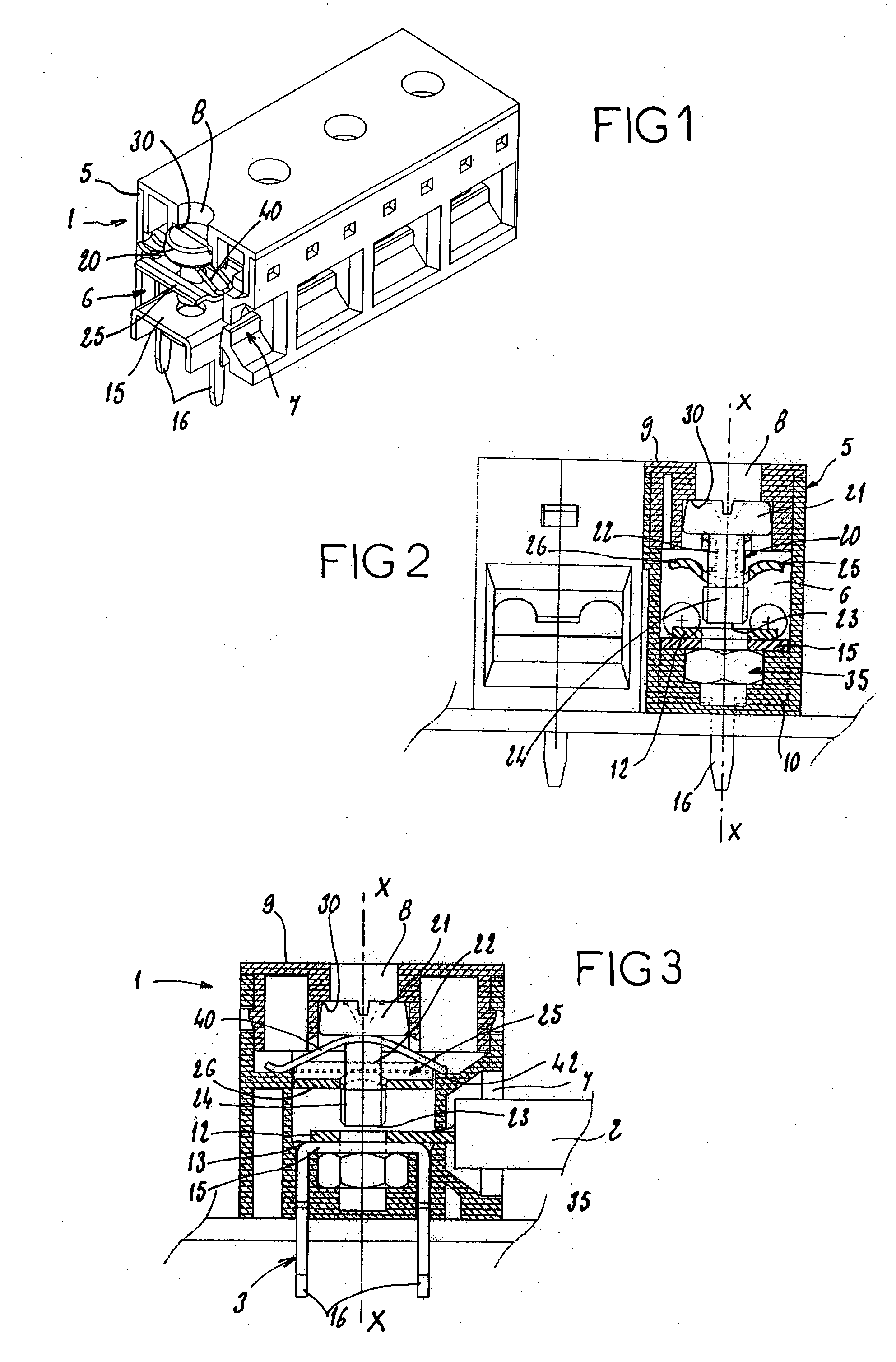Electrical connection device with protected contact
- Summary
- Abstract
- Description
- Claims
- Application Information
AI Technical Summary
Benefits of technology
Problems solved by technology
Method used
Image
Examples
first embodiment
[0032] The electrical connection device 1 according to the invention shown in FIGS. 1 to 3 is for connecting a conducting element 2 external to the device, to an electrical contact plate 3 belonging to this device.
[0033] The connection device described below can of course be understood as a connection terminal or a socket panel and the conducting element may be either a conducting cable with a stripped end, or a conducting ring terminal.
[0034] The electrical contact plate 3 may for example be embedded in an electronic board or in any other electrical system.
[0035] The connection device 1 comprises a case 5 which is made of an electrically insulating material and defines at least one housing 6. This electrically insulating case forms a virtually closed envelope vis-à-vis the external environment and comprises a connection opening 7 designed to allow the electrically conducting element 2 to be inserted into the housing 6 from the exterior of the device, and a work opening 8 for the ...
second embodiment
[0051] In the second embodiment shown in FIGS. 4 to 6, the clamping means 25 take the form of an internally threaded hole formed in the ring terminal 12 of the conducting element 2. The same reference numbers denote components identical or similar to the previous embodiment. The elastic restoring means 40 take the form of a thin element 44 which is also pressed against the flats 42 projecting from the walls 5 of the case as in the previous embodiment.
[0052] This second embodiment differs from the first embodiment in that the web 15 of the contact plate 3 is in contact with a flat 43 on one of the walls of the case 5 in the vicinity of the connection opening 7. The ring terminal 12 of the conducting element 2 is inserted into the opening 7 and laid against the web 15 of the plate 3, on the underside of the latter and bearing against the edge of the opening 7 from which the flat 43 projects.
[0053] Thus, after having put the conducting element 2 in position inside the housing 6, the s...
fourth embodiment
[0058] In the fourth embodiment shown in FIGS. 10 to 12, the shank 22 and the head 21 are of the same diameter. The clamping means 25 are represented in by the free end 23 of the screw 20. Thus, after inserting the ring terminal 12 of the conducting element 2 into the housing 6 for it to contact the web 15 of the plate 3, the screw 20 is simply screwed through the nut means 35 to bring the free end 23 against the ring terminal 12 and sandwich it between it and the web 15 of the plate 3.
[0059] As shown more particularly in FIG. 10, the nut means 35 are carried by walls 53 which are part of the same mass of material as the web 15 of the plate 3 and extend in the direction of the work opening 8, inside the housing 6. The nut means 35 take the form of an internally threaded thin element 54 extending transversely with respect to the screw 20.
[0060] Also, the connection opening 7 is closed by a hinged flap 55 supported by one of the walls of the case 5 and illustrated in the open and clo...
PUM
 Login to View More
Login to View More Abstract
Description
Claims
Application Information
 Login to View More
Login to View More - Generate Ideas
- Intellectual Property
- Life Sciences
- Materials
- Tech Scout
- Unparalleled Data Quality
- Higher Quality Content
- 60% Fewer Hallucinations
Browse by: Latest US Patents, China's latest patents, Technical Efficacy Thesaurus, Application Domain, Technology Topic, Popular Technical Reports.
© 2025 PatSnap. All rights reserved.Legal|Privacy policy|Modern Slavery Act Transparency Statement|Sitemap|About US| Contact US: help@patsnap.com



